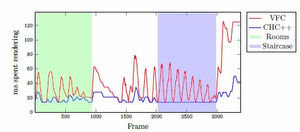Information
- Publication Type: Bachelor Thesis
- Workgroup(s)/Project(s):
- Date: June 2019
- Date (Start): 12. October 2015
- Date (End): 30. June 2019
- Matrikelnummer: 01025543
- First Supervisor: Michael Wimmer
Abstract
Point clouds received through various types of 3D-scanning techniques increase in size constantly. To compensate for this fact,the performance of rendering point clouds has to be improved accordingly. In addition to view frustum culling, occlusion culling can be used to reduce the number of points that has to be loaded. The occlusion culling algorithm I evaluate is called "CHC++: Coherent Hierarchical Culling Revisited" [MBW08]. For this thesis, I implemented a parameterizable point cloud renderer that allowed me to test varied values for multiple parameters. While not all parameters are defined in the evaluated paper, all influence the algorithm’s performance. My evaluation shows that the algorithm increases performance clearly for non-synthetic scenes. However, with the scenes in this evaluation, Tighter Bounding Volumes introduced a slight decrease in performance instead of improving it. Furthermore, using an SSD instead of an HDD did not yield the expected impact on the loading speed. Finally, I provide a general use case specific decision guideline for choosing values for the parameters. My mplementation produced for this thesis is available under the GNU Lesser General Public License, Version 3.Additional Files and Images
Weblinks
No further information available.BibTeX
@bachelorsthesis{Thann_2019_01,
title = "Evaluation of Coherent Hierarchical Culling Revisited with
Varied Parameters",
author = "J\"{u}rgen Thann",
year = "2019",
abstract = "Point clouds received through various types of 3D-scanning
techniques increase in size constantly. To compensate for
this fact,the performance of rendering point clouds has to
be improved accordingly. In addition to view frustum
culling, occlusion culling can be used to reduce the number
of points that has to be loaded. The occlusion culling
algorithm I evaluate is called "CHC++: Coherent Hierarchical
Culling Revisited" [MBW08]. For this thesis, I implemented a
parameterizable point cloud renderer that allowed me to test
varied values for multiple parameters. While not all
parameters are defined in the evaluated paper, all influence
the algorithm’s performance. My evaluation shows that the
algorithm increases performance clearly for non-synthetic
scenes. However, with the scenes in this evaluation, Tighter
Bounding Volumes introduced a slight decrease in performance
instead of improving it. Furthermore, using an SSD instead
of an HDD did not yield the expected impact on the loading
speed. Finally, I provide a general use case specific
decision guideline for choosing values for the parameters.
My mplementation produced for this thesis is available under
the GNU Lesser General Public License, Version 3.",
month = jun,
address = "Favoritenstrasse 9-11/E193-02, A-1040 Vienna, Austria",
school = "Research Unit of Computer Graphics, Institute of Visual
Computing and Human-Centered Technology, Faculty of
Informatics, TU Wien ",
URL = "https://www.cg.tuwien.ac.at/research/publications/2019/Thann_2019_01/",
}

 Bachelor Thesis
Bachelor Thesis image
image

